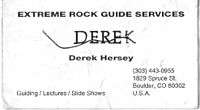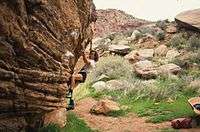Derek Hersey



Derek Geoffrey Hersey (26 October 1956 – 28 May 1993)[1][2][3][4] was a British rock climber and for many years an active participant in the Boulder, Colorado climbing scene. Hersey specialized in unroped "free solo" climbing, often in the 5.10–5.11 range.[3][5] Few climbers have tried to repeat his achievements, which include many of Colorado's hardest traditional routes.
Originally from Stretford, Greater Manchester, England, Hersey referred to Eldorado Canyon as his 'office', where he could be seen on any day of the week,[2][6] if not on a road trip to Yosemite National Park or elsewhere. He also referred to Boulder, Colorado's Liquor Mart as 'The Shrine', and described his climbing-chalk bag as 'my bag of courage'. Hersey was featured in Climbing Magazine[7][8] and posthumously in the film Front Range Freaks. He was 5 feet 11 inches (1.80 m) tall and weighed 138 pounds (63 kg).[3] He spoke with a strong Manchester accent.[6]
Hersey was introduced to climbing by his father, who went hiking near Manchester every week. Hersey learned to climb on the gritstone of the Peak District National Park in Derbyshire. In 1983, after being unemployed for five years in England, Hersey decided to travel to the United States, where he lived for the rest of his life.[6]
Hersey's efforts to push the limits of his sport earned him the nickname "Dr. Death".[3][6][9][10] Hersey was perhaps best known for his exploits in Eldorado Canyon, but his résumé included many other challenging ascents (and descents).[6] Among them was his free-solo ascent of Crack of Fear, a sustained 5.10+ off-width route at Lumpy Ridge, Colorado; and an impressive effort on the Diamond (a 275-metre (902 ft) wall on Longs Peak), when he free-soloed ascents of two routes and downclimbed another in a single day.[6] He was well known for pumping up and down laps on the sustained 5.10 route Rosy Crucifixion in Eldorado Canyon as a work-out regime.
Derek Hersey died on 28 May 1993 in an accident while soloing the Steck-Salathé Route without protective gear, on Sentinel Rock in Yosemite National Park.[3][4][11] He fell several hundred feet to his death.[2][4][11] Craig Luebben, a friend of Hersey, speculated that he encountered slippery rock. Although there was no rainfall officially reported in the area that day,[1] a later report concluded that "rain-slicked rock" contributed to his fall.[12] The search for Hersey's body was featured in a report on the CBS News program 48 Hours.[9][10]
References
| Wikimedia Commons has media related to Derek Hersey. |
- 1 2 Willman, David (31 May 1993). "Premier Rock Climber Falls to His Death in Yosemite : Accident: Derek Hersey was a free-soloist, using no ropes or equipment. A friend says he may have encountered moisture and slipped on Sentinel Rock.". Los Angeles Times. Retrieved 15 June 2013.
- 1 2 3 Osius, Alison (26 June 1993). "Obituary: Derek Hersey". The Independent. London. Retrieved 15 June 2013. (Gives Hersey's date of death incorrectly as 20 May 1993.)
- 1 2 3 4 5 Ghiglieri, Michael P.; Farabee, Charles R. "Butch" Jr. (2007). Off the Wall: Death in Yosemite. Flagstaff: Puma Press. pp. 315–316, 365. ISBN 978-0-9700973-6-1.
- 1 2 3 Roberts, Paul (1 November 1994). "Risk". Psychology Today. Retrieved 15 June 2013.
- ↑ "Derek Hersey, Climber, Dies at 39 in Cliff Fall". The New York Times. 2 June 1993. Retrieved 5 July 2011.
- 1 2 3 4 5 6 Whitehouse, Annie (1999). "An Interview with Derek Hersey". In Long, John; Sponholz, Hai-Van K. The High Lonesome: Epic Solo Climbing Stories. Helena, MT: Falcon Publishing. pp. 73–85. ISBN 1-56044-858-X.
- ↑ Climbing, April/May 1992, quoted in Ghiglieri and Farabee.
- ↑ "1 Climbing Magazine Index 1970-1994 Issues 1 through 149 compiled by Eve Tallman & Christopher Trudeau" (PDF). Retrieved 5 July 2011.
- 1 2 "Rescue At High Cost - CBS News". Retrieved 5 July 2011.
- 1 2 Gutman, Bill; with Frederick, Shawn (2002). Being Extreme: Thrills and Dangers in the World of High-Risk Sports. New York: Citadel Press Books. pp. 66–67. ISBN 0-8065-2354-9.
- 1 2 Eldred, Sheila Mulrooney (8 April 2004). "Edge of Oblivion - Free-solo rock climbers feel spiritual lure.". Fresno Bee., cited in "Yosemite Association - Newsroom". Yosemite Association. Archived from the original on 20 November 2008. Retrieved 27 February 2012.
- ↑ Belcher, Bill (November 18, 2006). "Free-Solo Climber Prefers the Unencumbered Ascent". New York Times. Retrieved April 11, 2015.
External links
- Video of Hersey climbing (broken) on YouTube
- Fresno Bee article at the Wayback Machine (archived November 20, 2008)